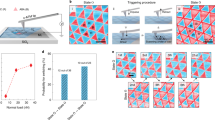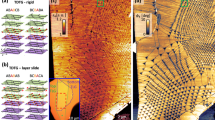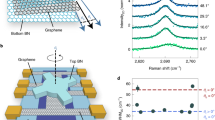Abstract
Topological dislocations and stacking faults greatly affect the performance of functional crystalline materials1,2,3. Layer-stacking domain walls (DWs) in graphene alter its electronic properties and give rise to fascinating new physics such as quantum valley Hall edge states4,5,6,7,8,9,10. Extensive efforts have been dedicated to the engineering of dislocations to obtain materials with advanced properties. However, the manipulation of individual dislocations to precisely control the local structure and local properties of bulk material remains an outstanding challenge. Here we report the manipulation of individual layer-stacking DWs in bi- and trilayer graphene by means of a local mechanical force exerted by an atomic force microscope tip. We demonstrate experimentally the capability to move, erase and split individual DWs as well as annihilate or create closed-loop DWs. We further show that the DW motion is highly anisotropic, offering a simple approach to create solitons with designed atomic structures. Most artificially created DW structures are found to be stable at room temperature.
This is a preview of subscription content, access via your institution
Access options
Access Nature and 54 other Nature Portfolio journals
Get Nature+, our best-value online-access subscription
$29.99 / 30 days
cancel any time
Subscribe to this journal
Receive 12 print issues and online access
$259.00 per year
only $21.58 per issue
Buy this article
- Purchase on Springer Link
- Instant access to full article PDF
Prices may be subject to local taxes which are calculated during checkout




Similar content being viewed by others
References
Zou, X. & Yakobson, B. I. An open canvas—2D materials with defects, disorder, and functionality. Acc. Chem. Res. 48, 73–80 (2015).
Uchic, M. D., Dimiduk, D. M., Florando, J. N. & Nix, W. D. Sample dimensions influence strength and crystal plasticity. Science 305, 986–989 (2004).
Dimiduk, D. M., Uchic, M. D. & Parthasarathy, T. A. Size-affected single-slip behavior of pure nickel microcrystals. Acta Mater. 53, 4065–4077 (2005).
Ju, L. et al. Topological valley transport at bilayer graphene domain walls. Nature 520, 650–655 (2015).
Yao, W., Yang, S. A. & Niu, Q. Edge states in graphene: from gapped flat-band to gapless chiral modes. Phys. Rev. Lett. 102, 096801 (2009).
Martin, I., Blanter, Y. M. & Morpurgo, A. F. Topological confinement in bilayer graphene. Phys. Rev. Lett. 100, 036804 (2008).
Zhang, F., MacDonald, A. H. & Mele, E. J. Valley Chern numbers and boundary modes in gapped bilayer graphene. Proc. Natl Acad. Sci. USA 110, 10546–10551 (2013).
Vaezi, A., Liang, Y., Ngai, D. H., Yang, L. & Kim, E.-A. Topological edge states at a tilt boundary in gated multilayer graphene. Phys. Rev. X 3, 021018 (2013).
Semenoff, G. W., Semenoff, V. & Zhou, F. Domain walls in gapped graphene. Phys. Rev. Lett. 101, 087204 (2008).
Zhang, F., Jung, J., Fiete, G. A., Niu, Q. & MacDonald, A. H. Spontaneous quantum Hall states in chirally stacked few-layer graphene systems. Phys. Rev. Lett. 106, 156801 (2011).
Butz, B. et al. Dislocations in bilayer graphene. Nature 505, 533–537 (2014).
Jiang, L. et al. Soliton-dependent plasmon reflection at bilayer graphene domain walls. Nat. Mater. 15, 840–844 (2016).
Alden, J. S. et al. Strain solitons and topological defects in bilayer graphene. Proc. Natl Acad. Sci. USA 110, 11256–11260 (2013).
Koshino, M. Electronic transmission through AB–BA domain boundary in bilayer graphene. Phys. Rev. B 88, 115409 (2013).
Bao, W. et al. Stacking-dependent band gap and quantum transport in trilayer graphene. Nat. Phys. 7, 948–952 (2011).
Lui, C. H., Li, Z., Mak, K. F., Cappelluti, E. & Heinz, T. F. Observation of an electrically tunable band gap in trilayer graphene. Nat. Phys. 7, 944–947 (2011).
Craciun, M. F. et al. Trilayer graphene is a semimetal with a gate-tunable band overlap. Nat. Nanotech. 4, 383–388 (2009).
Guinea, F., Castro Neto, A. H. & Peres, N. M. R. Electronic states and landau levels in graphene stacks. Phys. Rev. B 73, 245426 (2006).
Koshino, M. & McCann, E. Gate-induced interlayer asymmetry in ABA-stacked trilayer graphene. Phys. Rev. B 79, 125443 (2009).
Zhang, F., Sahu, B., Min, H. & MacDonald, A. H. Band structure of ABC-stacked graphene trilayers. Phys. Rev. B 82, 035409 (2010).
Zou, K., Zhang, F., Clapp, C., MacDonald, A. H. & Zhu, J. Transport studies of dual-gated ABC and ABA trilayer graphene: band gap opening and band structure tuning in very large perpendicular electric fields. Nano Lett. 13, 369–373 (2013).
Yankowitz, M. et al. Electric field control of soliton motion and stacking in trilayer graphene. Nat. Mater. 13, 786–789 (2014).
Wang, X. et al. Unfolding of vortices into topological stripes in a multiferroic material. Phys. Rev. Lett. 112, 247601 (2014).
Lee, C. et al. Frictional characteristics of atomically thin sheets. Science 328, 76–80 (2010).
Hull, D. & Bacon, D. J. Introduction to Dislocations 5th edn 63–83 (Butterworth-Heinemann, Oxford, 2011).
Fei, Z. et al. Gate-tuning of graphene plasmons revealed by infrared nano-imaging. Nature 487, 82–85 (2012).
Chen, J. et al. Optical nano-imaging of gate-tunable graphene plasmons. Nature 487, 77–81 (2012).
Choi, J. S. et al. Friction anisotropy–driven domain imaging on exfoliated monolayer graphene. Science 333, 607–610 (2011).
Sader, J. E., Chon, J. W. M. & Mulvaney, P. Calibration of rectangular atomic force microscope cantilevers. Rev. Sci. Instrum. 70, 3967–3969 (1999).
Acknowledgements
We acknowledge helpful discussions with M. Asta, D. Chrzan, B. Yacobson, M. Poschmann and R. Zucker. We thank A. Zettl, Y. Zhang, T. Wang and Y. Sheng for their help on sample preparation. The near-field infrared nanoscopy measurements and plasmon analysis was supported by the Director, Office of Science, Office of Basic Energy Sciences, Materials Sciences and Engineering Division of the US Department of Energy under contract no. DE-AC02-05-CH11231 (Sub-wavelength Metamaterial Program) and National Key Research and Development Program of China (grant number 2016YFA0302001). The bilayer graphene DW sample fabrication and characterization is supported by the Office of Naval Research (award N00014-15-1-2651). L.J. acknowledges support from International Postdoctoral Exchange Fellowship Program 2016 (No.20160080). Z.S. acknowledges support from the Program for Professor of Special Appointment (Eastern Scholar) at Shanghai Institutions of Higher Learning.
Author information
Authors and Affiliations
Contributions
F.W. and Z.S. conceived the project. F.W., Y.-R.S. and H.-J.G. supervised the project. G.Z. helped to design the study with Z.S. and F.W. L.J., Z.S. and C.J. performed the near-field infrared measurements and DW manipulation work. S.W. and L.J. performed the SVM measurement. L.J. and S.Z. made the FET devices. M.I.B.U. carried out the SEM measurements. L.J., S.W., Z.S. and F.W. analysed the data. All authors discussed the results and contributed to writing the manuscript.
Corresponding authors
Ethics declarations
Competing interests
The authors declare no competing financial interests.
Additional information
Publisher’s note: Springer Nature remains neutral with regard to jurisdictional claims in published maps and institutional affiliations.
Supplementary information
Supplementary Information
Supplementary Figures 1–10, Supplementary References.
Rights and permissions
About this article
Cite this article
Jiang, L., Wang, S., Shi, Z. et al. Manipulation of domain-wall solitons in bi- and trilayer graphene. Nature Nanotech 13, 204–208 (2018). https://doi.org/10.1038/s41565-017-0042-6
Received:
Accepted:
Published:
Issue Date:
DOI: https://doi.org/10.1038/s41565-017-0042-6
This article is cited by
-
Electron/infrared-phonon coupling in ABC trilayer graphene
Nature Communications (2024)
-
Domino-like stacking order switching in twisted monolayer–multilayer graphene
Nature Materials (2022)
-
Bi-state switch in moiré stacking
Nature Materials (2022)
-
Interface nano-optics with van der Waals polaritons
Nature (2021)
-
Experimental nanomechanics of 2D materials for strain engineering
Applied Nanoscience (2021)



